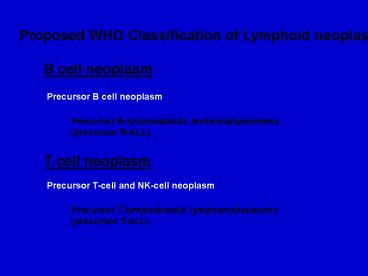Proposed WHO Classification of Lymphoid neoplasm - PowerPoint PPT Presentation
1 / 18
Title:
Proposed WHO Classification of Lymphoid neoplasm
Description:
Precursor T-cell and NK-cell neoplasm. Precursor T-lymphoblastic ... Extra-nodal marginal zone B cell lymphoma of MALT type. Nodal marginal zone B cell lymphoma ... – PowerPoint PPT presentation
Number of Views:217
Avg rating:3.0/5.0
Title: Proposed WHO Classification of Lymphoid neoplasm
1
Proposed WHO Classification of Lymphoid neoplasm
B cell neoplasm
Precursor B cell neoplasm
Precursor B-lymphoblastic leukemia/lymphoma (precu
rsor B-ALL)
T cell neoplasm
Precursor T-cell and NK-cell neoplasm
Precursor T-lymphoblastic lymphoma/leukemia
(precursor T-ALL)
2
Mature (peripheral) B cell neoplasm
B-cell chronic lymphocytic leukemia/SLL
Lymphoplasmacytic lymphoma
Splenic marginal zone B-cell lymphoma
Hairy cell leukemia
Plasma cell myeloma/plasmacytoma
Extra-nodal marginal zone B cell lymphoma of MALT
type
Nodal marginal zone B cell lymphoma
Follicular lymphoma
Mantle cell lymphoma
3
Mature (peripheral) B cell neoplasm (contd)
Diffuse large B cell lymphoma
Mediastinal B cell lymphoma
Primary effusion lymphoma
Burkitt lymphoma/Burkitt cell leukemia
4
Mature (peripheral) T cell neoplasm
T-cell prolymphocytic leukemia
T-cell granular lymphocytic leukemia
Aggressive NK-cell leukemia
Adult T-cell leukemia/lymphoma (HTLV1)
Extranodal NK/T cell lymphoma, nasal type
Enteropathy type T cell lymphoma
Hepatosplenic gamma delta T cell lymphoma
Subcutaneous panniculitis-like T cell lymphoma
Mycosis fungoides/Sezary syndrome
5
Mature (peripheral) T cell neoplasm (contd)
Anaplastic large cell lymphoma, T/null cell,
primary cutaneous
Peripheral T cell lymphoma, NOS
Angioimmunoblastic T cell lymphoma
Anaplastic large cell lymphoma, T/null cell,
primary systemic
6
Hodgkin's lymphoma (Hodgkin's disease)
Nodular lymphocyte predominant Hodgkin's lymphoma
Classical Hodgkin's lymphoma
Nodular sclerosis Hodgkin's lymphoma (grades 1
and 2)
Lymphocyte-rich classical Hodgkin's lymphoma
Mixed cellularity Hodgkin's lymphoma
Lymphocyte depletion Hodgkin's lymphoma
7
Pediatric Follicular Lymphoma
- Rare lymphoma subtype in children (1-2)
- 60 present in head and neck
- Tonsils, nasopharynx
- Other sites lymph nodes, GI tract, testis
- Many differences with FL in adults
- Usually Grade II-III
- Bcl-2 usually negative (both protein bcl-2R)
- Male Female ratio 31
- 85 present with Stage I or II disease
- 75 CR with low relapse rate
8
BL
Children
LBCL
BL
Adults
9
Burkitt-like lymphoma should exist?
Burkitt-like lymphoma should be included in
Diffuse large B cell lymphoma
or
Morphologic variant of Burkitt lymphoma
10
Burkitt and Burkitt-like Lymphomas
May show follicular colonization
Cytologically tumor cells resemble the small
blasts of the dark zone of the GC
High rate of somatic mutations of Ig VH
BCL-6, CD 10
Evidence favors a germinal center derivation
11
Burkitt-like Lymphomas
- Similar to BL, but with greater variation in
nuclear morphology - MIB-1 100, CD10 , bcl-2 -
- Cytogenetics or molecular genetics desirable for
diagnosis - should have a c-myc translocation - This morphologic variant more common in
immunodeficiency states
12
In the WHO classification
The term Burkitt-like lymphoma is retained
Burkitt-like lymphoma will be considered a
variant of Burkitt lymphoma
Major criteria
13
BURKITT LYMPHOMA
Morphologic Variants
Classical Burkitt lymphoma
Subtypes, clinical genetic
Endemic
Sporadic
Immunodeficiency-associated
14
Anaplastic Large Cell Lymphoma
- Paradigm for process used to define disease
entities (REAL) - First recognized based on
- Morphology - sinusoidal growth
- Antigenic phenotype - CD30
- Studies of molecular pathogenesis led to new
diagnostic tools - RT-PCR and ALK-1 monoclonal antibody
- New diagnostic tools define the borderlands of
the disease
15
Anaplastic Large Cell LymphomaClinical Features
- Presents most commonly in lymph nodes
- Cutaneous involvement variable
- Most common in children, young adults
- Frequent presence of systemic symptoms
- B symptoms or high IPI less often predict poor
outcome (in contrast to most other NHL) - Aggressive natural history but good response to
chemotherapy
16
DISTRIBUTION OF ANAPLASTIC LARGE CELL LYMPHOMA BY
AGE (267 cases)
Sex Ratio 1.34
Number of cases
Age
17
- Survival of 154 patients with ALCL
100
ALK (n132)
Survival
ALK - (n22)
75
plt0.001
50
25
0
120
180
240
60
Months
18
Clinical Significance of ALK in Anaplastic
Large Cell Lymphoma
- ALK cases are seen in younger age groups
- Children and young adults MgtgtF
- ALK cases have better prognostic than ALK-,
irrespective of other clinical features i.e.
age, stage or IPI - Conclusion
- ALK ALCL is probably a distinct disease entity,
separate from ALK- ALCL































